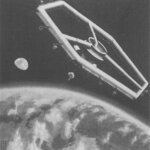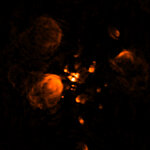Space

You've probably seen movies of orbital space habs spinning for artificial gravity. But did you know, that nobody has ever tested this to see how it works out in practise? We know that weightlessnes is bad for health, especially long term, with many potential medical issues. But do we need full g, or Mars g, or lunar g to stay healthy? Nobody knows. Can we cope with a spinning hab a few meters across or do we need to think about a huge hab or tether system a couple of hundred meters across or larger? Again nobody knows.
Here is a very early 1962 design for a hexagonal rotating orbital space…
The origin of life remains a great mystery in biology. Billions of years of continental drift erased most of the record, and all that's left of the first half billion years of evolution are some millimeter sized zircons embedded in later rocks. These can tell us the composition of the early Earth's atmosphere (through pockets of air trapped in the crystals) but not much else. And there is much to discover. The most primitive cells we know are far too large, and modern DNA based life is far too complex for the first cells.
Mars is one of the best places to go to try to fill in this gap in our…

Stars like Sol are relatively easy to understand, because they are numerous, and live for billions of years, but high mass stars are rare and live for only a few million years. As a result, understanding their early evolution has been a challenge.
Simple models suggested that when high mass stars become hot enough to ionize the gas around them, heating it to thousands of degrees, the gas will quickly expand. But decades ago, astronomers found that regions of ionized gas around young high mass stars remain small (under a third of a light-year) for ten times longer than they should if…

In 2005,the Japanese spacecraft Hayabusa revealed that the near-Earth asteroid (25143) Itokawa has a strange peanut shape, leading to questions about why. Now, using ground-based observations, a group has measured the speed at which Itokawa spins and how that spin rate is changing over time and combined these observations with theoretical work on how asteroids radiate heat.
To probe its internal structure, Stephen Lowry of the University of Kent and colleagues used images gathered from 2001 to 2013. They analyzed images from ESO's New Technology Telescope (NTT) at the…

Kepler-413b is located 2,300 light-years (about 700 parsecs) away in the constellation Cygnus. It circles a close pair of orange and red dwarf stars every 66 days but what really makes Kepler-413b unusual is that it precesses wildly on its spin axis - The tilt of the spin axis of the planet can vary by as much as 30 degrees over 11 years with respect to the plane of the binary star's orbit.
Compare that to the Earth's rotational precession, which is a far more modest 23.5 degrees over 26,000 years. This far-off planet is far-out and all of this complex movement leads to rapid and erratic…
In my article Our Spacecraft Could Look Straight At an Extraterrestrial Microbe - And Not See a Thing! we found out that present day extraterrestrial microbes in our solar system would be sparse and hidden from the harsh surface conditions, and ancient life would deteriorate over millions of years in the surface conditions. Our search is likely to be long and to involve digging and drilling in many different places in our solar system. But where should we look for these traces of life?
Let's start with the most likely and then move through to the less likely places. Our search will take us to…

The linchpin location of the "Star Wars" franchise was the planet Tatooine, home to both Luke Skywalker and Obi-Wan Kenobi. It, along with its twin suns, appeared in every movie of the franchise except "The Empire Strikes Back".
How would such a planet, orbiting two stars, form? There are few environments more extreme than a binary star system, if you are forming a planet.
Kepler-34(AB)b has some answers, according to a new study. Like Tatooine, Kepler-34(AB)b is a circumbinary planet, its orbit encompasses two stars. Since powerful gravitational perturbations from two stars lead to…

As a mathematician I'm used now to the proofs of scientists, which can seem puzzlingly non rigorous at first. But the mathematics of Planetary Protection are particularly eccentric, even bizarre. They are based on out dated science from the 1970s, and arbitrary "magic numbers" and assumptions made by Carl Sagan and others based on those assumptions. There have been many suggestions that this needs to change but so far nobody has come up with a clear way ahead for an alternative.
Meanwhile the planetary protection officers and the COSPAR scientists continue to apply these regulations based on…
The search for extraterrestrial life goes on, sort of. We do it, as half-heartedly as we do anything in space, because we're more afraid of being alone than finding another civilization. Or vice versa.
But we may not be looking in the best spots, even if we are looking in the Habitable Zones. Looking for planets or moons outside the "stellar habitable zone" might lead to environments that are even more favorable to supporting life than here on Earth, according to a crazy/insightful article in Astrobiology. These superhabitable worlds might have unique characteristics and be ideal targets for…
We know now that asteroids are relics that can tell us what the planets in our solar system may have been like before they formed cores and mantles and crusts. But that wasn't always the case. Until the past few decades asteroids were viewed in a more static way. Those that formed near the sun remained near the sun, those that formed farther out stayed on the outskirts.
Then it was discovered that some asteroids have compositions that don't match their locations in space. Those that looked like they formed in warmer environments were found further out in the solar system, and vice versa…